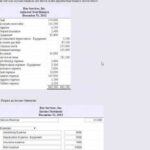
All of our content is based on objective analysis, and the opinions are our own. For example, consider the case of an air ticket invoice for business travel sold to a company that makes widgets. This is a very important concept to understand when performing financial analysis of a company.
- Accounts payable turnover is a ratio that measures the speed with which a company pays its suppliers.
- Either an expense or an asset forms part of the debit offset entry in the case of accounts payable.
- If the company is employing a perpetual inventory system, the debit part of the entry would consist of “inventory account” rather than the “purchases account”.
- Inventory includes the raw materials needed to produce goods for sale or finished goods.
- We may earn a commission when you click on a link or make a purchase through the links on our site.
Would you prefer to work with a financial professional remotely or in-person?
When Robert Johnson Pvt Ltd makes payment to its supplier, the accounts payable account gets debited. This is because Robert Johnson’s current liability is reduced by $200,000. The offsetting credit entry for such a transaction is made to the cash account, because the cash worth $200,000 gets reduced. Robert Johnson Pvt Ltd needs to determine its accounts payable turnover ratio for 2024. It had an opening accounts payable balance of $500,000 and a closing accounts payable balance of $650,000.
Accounts payable (AP), or “payables,” refers to a company’s short-term obligations owed to its creditors or suppliers, which have not yet been paid. Accounts Payable (AP) is an accounting term that refers to money owed to suppliers, vendors, or employees for goods or services purchased on credit. If not, the payables department must contact the supplier to request that a corrected invoice be sent.

When an asset other than merchandise inventory is purchased on account:
However, it can also operate as a debit once the money is paid to the vendor. Accounts payable turnover refers to the ratio which measures the speed at which your business makes payments to its creditors and suppliers, indicating the short-term liquidity of your business. A sub-ledger consists of the details of all individual transactions of a specific account like accounts payable, accounts receivable, or fixed assets.
Process Payment
This can be done manually by signing the invoice or electronically by clicking a button in your accounting software. Accounts payable refers to the amount of money a business owes to its suppliers and vendors for goods or services received. Because accounting books must be balanced on both sides of the online payroll services for small businesses ledger, the accounting entry is also recorded as a corresponding debit to another account. Commonly, a supplier will ship a product, issue an invoice, and collect payment later. This is a cash conversion cycle, or a period of time during which the supplier has already paid for raw materials but has not been paid in return by the final customer. Accounts payables turnover is a key metric used in calculating the liquidity of a company, as well as in analyzing and planning its cash cycle.
Acme Manufacturing, for example, has $100,000 in payables from 0 to 30 days old, and $15,000 due in the 31-to-60-days-old category. Since we typically follow a double-entry bookkeeping system, there has to be an offsetting debit entry to be made in your company’s general ledger. Either an expense or an asset forms part of commercial solar arrays and macrs depreciation the debit offset entry in the case of accounts payable. It is important to note that the accounts payable category represents the short-term obligations of your business. Meaning it represents the aggregate amount of short-term obligations that you have towards suppliers of goods or services. Generally, QuickBooks provides a list of standard accounts, like accounts payable, accounts receivable, purchase orders, payroll expenses, etc.
Understanding Accounts Payable (AP) With Examples and How to Record AP
The simplest case is the two way matching between the invoice itself and the purchase accounting journal entries order. Accounts payable turnover is the total purchases on credit divided by the average accounts payable balance. Business owners must monitor the accounts payable balance and use a cash forecast to plan the payments. A company’s cash position is important because every firm needs a minimum cash balance to operate. Owners must consider the timing of cash inflows from accounts receivable and the cash outflows required for accounts payable.
Upon receiving the debit note, the seller issues a credit note (also known as credit memo) to the buyer, informing him that his account has been credited. On each scheduled payment date, the accountant runs a preliminary check register and reviews it to ensure that all stated payments should be made. The remaining payments are made, using either checks or electronic payments. Depending on the controls used, these payments may need to be approved before they are issued. Automation can lead to significant cost savings by reducing the need for manual intervention.
Leave a Reply